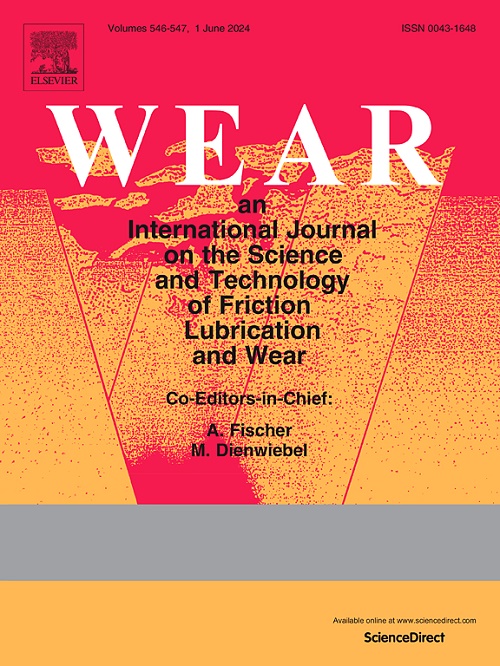氢对激光熔覆 FeCoCrNiMo0.2 高熵合金涂层摩擦磨损行为的影响
IF 5.3
1区 工程技术
Q1 ENGINEERING, MECHANICAL
引用次数: 0
摘要
本研究调查了高速列车车轴上的激光包覆高熵合金(HEA)涂层,以提高其在特定摩擦条件下的耐磨性。潮湿和酸性环境中的车轴会吸收氢气,导致氢气在晶界中积累,从而削弱其结构,并在交变应力作用下造成损坏。尽管如此,氢损伤对 HEA 涂层的烧蚀磨损行为的影响尚未得到研究。为了解决这个问题,我们对激光包覆的 FeCoCrNiMo0.2 涂层和 GCr15 钢球摩擦系统进行了摩擦磨损测试,评估了它们在氢暴露前后的性能。研究结果表明,在恒定载荷 Fn = 10N 和位移振幅 D = 50 μm 的条件下,系统处于充氢状态时的摩擦系数、最大磨损深度、磨损量和磨损率都比未充氢时有所增加。具体来说,摩擦系数从 0.60 增加到 0.93,最大磨损深度从 2.82 μm 增加到 3.63 μm,磨损体积从 14.106 × 104μm3 增加到 22.098 × 104μm3,磨损率从 28.213 × 10-6 mm/Nm 增加到 36.600 × 10-6 mm/Nm。在充氢状态下,摩擦系数、最大磨损深度、磨损体积和磨损率都有所增加。这是由于氢损伤造成的,包括涂层表面点状凹坑和裂纹的形成、应力集中以及氢渗入材料造成的脆性破坏。氢的存在使涂层表面更容易脱落,从而产生更细的磨损碎屑、更深的沟槽和更严重的氧化。这些因素加速了涂层的磨损。这一发现将有助于开发和改进先进的氢环境材料表面改性技术。本文章由计算机程序翻译,如有差异,请以英文原文为准。
Effects of hydrogen on the fretting wear behavior of laser cladded FeCoCrNiMo0.2 high entropy alloy coating
This study investigates laser-cladded high entropy alloy (HEA) coatings on high-speed train axles to enhance wear resistance under specific fretting conditions. Axles in humid and acidic environments absorb hydrogen, leading to accumulation in grain boundaries, which weakens their structure and causes damage under alternating stress. Despite this, the impact of hydrogen damage on the fretting wear behavior of HEA coatings has not been explored. To address this, we performed fretting wear tests on a laser-cladded FeCoCrNiMo0.2 coating and a GCr15 steel ball friction system, evaluating their performance before and after hydrogen exposure. The results of the study indicate that under a constant load of Fn = 10N and a displacement amplitude of D = 50 μm, the friction coefficient, maximum wear depth, wear volume, and wear rate increased when the system was in the hydrogen charging state compared to the non-hydrogen charging state. Specifically, the friction coefficient increased from 0.60 to 0.93, the maximum wear depth increased from 2.82 μm to 3.63 μm, the wear volume increased from 14.106 × 104μm3 to 22.098 × 104μm3, and the wear rate increased from 28.213 × 10−6 mm/Nm to 36.600 × 10−6 mm/Nm. Under the hydrogen charging state, the friction coefficient, maximum wear depth, wear volume, and wear rate all increased. This is due to hydrogen damage, including the formation of pitting pits and cracks on the surface of the coating, stress concentration, and brittle failure caused by hydrogen infiltration into the material. The presence of hydrogen makes the surface of the coating more prone to detachment, resulting in finer wear debris, deeper grooves, and increased oxidation. These factors accelerate the wear of the coating. This finding will contribute to the development and improvement of advanced surface modification techniques for materials in the hydrogen environment.
求助全文
通过发布文献求助,成功后即可免费获取论文全文。
去求助
来源期刊

Wear
工程技术-材料科学:综合
CiteScore
8.80
自引率
8.00%
发文量
280
审稿时长
47 days
期刊介绍:
Wear journal is dedicated to the advancement of basic and applied knowledge concerning the nature of wear of materials. Broadly, topics of interest range from development of fundamental understanding of the mechanisms of wear to innovative solutions to practical engineering problems. Authors of experimental studies are expected to comment on the repeatability of the data, and whenever possible, conduct multiple measurements under similar testing conditions. Further, Wear embraces the highest standards of professional ethics, and the detection of matching content, either in written or graphical form, from other publications by the current authors or by others, may result in rejection.
 求助内容:
求助内容: 应助结果提醒方式:
应助结果提醒方式:


